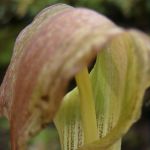| Common Name: |
Dragon Plant |
| Botanical Name: |
Arisaema consanguineum |
| Genus: |
Arisaema |
| Family: |
Araceae |
| Native Location: |
E Himalayas to N Thailand, C China, Taiwan |
| Cultivation: |
Moist, well-drained, rich soil in dappled shade. Corms rot if too wet or cold. New foliage may be damaged by spring frosts. |
| Propagation: |
By seed sown in autumn or spring; by offset corms removed when dormant. |
| Harvest: |
Corms are lifted in autumn or in winter when plants are dormant, and dried for decoctions. |
| Height: |
1m (3ft) |
| Width: |
30cm (12in) |
| Hardiness: |
Z7-9 |
| Parts Used: |
Corms (nan xing) |
| Properties: |
An acrid, irritant herb that acts as an expectorant and relaxes convulsions. Research indicates possible anti-cancer effects. |
| Medicinal Uses: |
Internally for coughs with profuse phlegm, tumors, cervical cancer, epilepsy, tetanus, and complaints involving convulsions and spasmodic twitching. |
| Warning: |
All parts are hamful if eaten. Irritant to skin, eyes, and mucous membranes. |
| Bibliography: |
Encyclopedia of Herbs by Deni Brown Copyright © 1995, 2001 Dorling Kindersley Limited. pg 128 |

